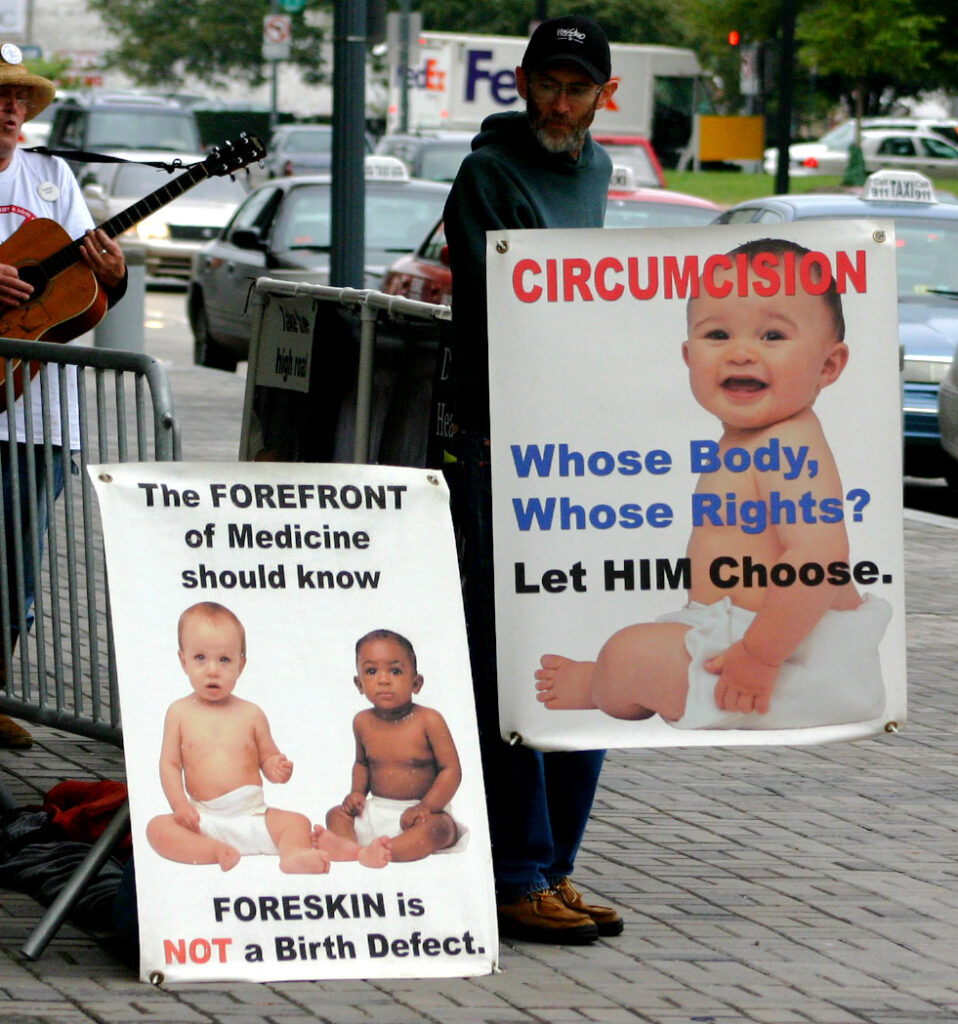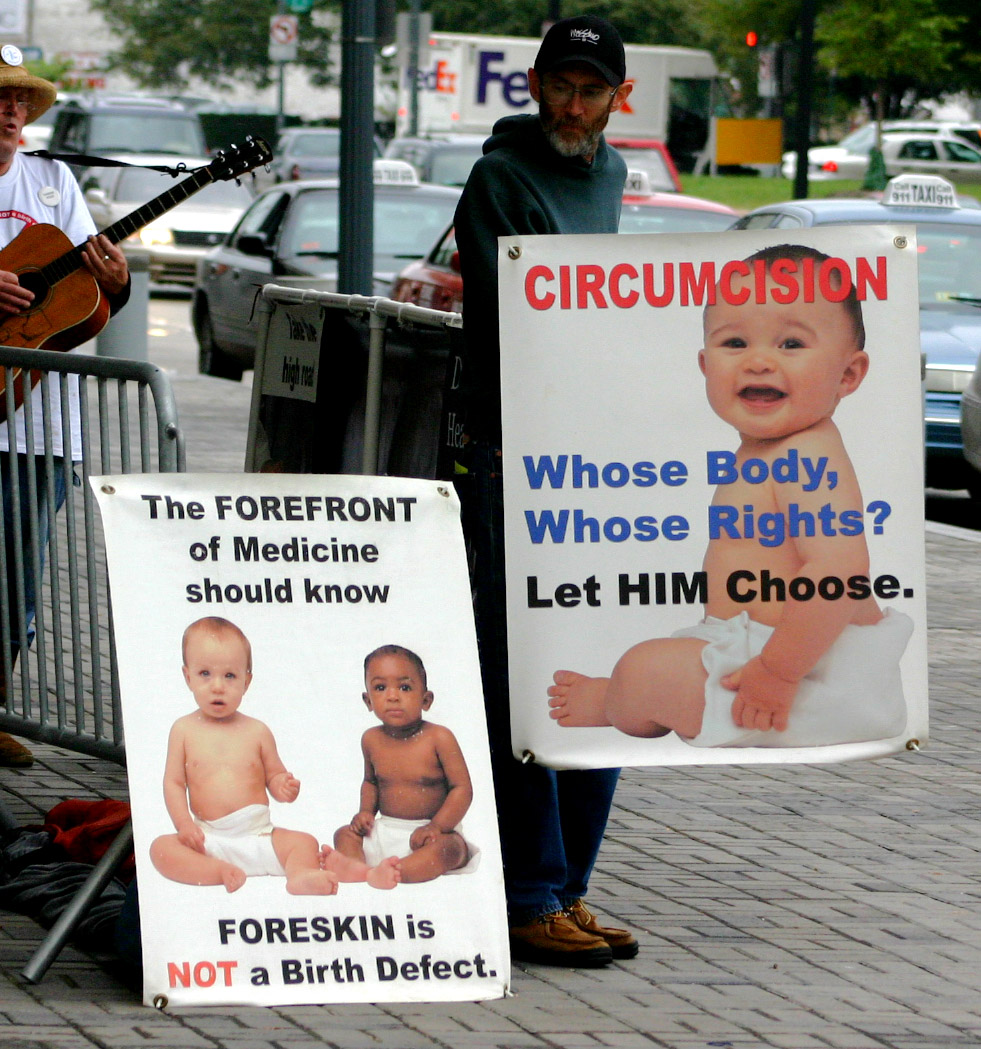Text by Henrylito D. Tacio
Photos from Wikipedia
“Only 30 to 33 percent of males aged 15 and above are circumcised.” — World Health Organization
***
Circumcision is probably the world’s most widely performed procedure. According to some studies, approximately one-third of males worldwide are circumcised, most often for reasons other than medical indications.
To people who practice Judaism, circumcision is very important. In fact, over 90% of adherents have the procedure performed as a religious obligation. The basis for its observance is found in the Torah of the Hebrew Bible, in Genesis chapter 17, in which a covenant of circumcision is made with Abraham and his descendants.
Surgical removal of the foreskin
Circumcision is actually the surgical removal of all or part of the prepuce (pronounced “pre’pyoos”) – that flap of tissue covering the head of the penis – or foreskin. In the United States and most industrialized countries, circumcision is usually performed on the first or second day after birth and usually takes only about 5 to 10 minutes. “It becomes more complicated and riskier in infants older than two months and in boys and men,” American doctors claim.
But not so in the Philippines, where most boys are circumcised between the ages of 10 and 12. If you go to the rural areas, especially during summer, you will see the long line of boys waiting for their turn to be cut. “They’re proud to go back to school, to talk about how brave they were,” says one doctor.
Aside from there being more time to recuperate after the surgical procedure, the other reason why summer is the most popular time for circumcision in the country is its being the most ideal time both for those conducting the medical mission and for those who will be circumcised.
“It’s the optimal time for us and the kids, because we’re on break, and they have ample recovery time, so their circumcision won’t interfere with school,” Dr. Victoria Dimacali was quoted as saying by GMA News Online.
Here’s what a foreigner says of the circumcision he had witnessed: “Filipino boys are circumcised by the group during summer time under the banana tree by a manunuli using dorsal slit method that takes only few seconds without anesthesia. They don’t mind being seen by others kids to be circumcised, too.”
Circumcision in the Philippines is not related to religion. The vast majority of Filipinos are circumcised – whether they are Catholic, Muslim, or whatever. It is a “coming of age” ritual and traditional for a boy to prove his manhood properly, it is done without an anesthetic.
Ancient operation
Until now, there is no firm consensus as to how it came to be practiced worldwide. One theory is that it began in one geographic area and spread from there; another is that several different cultural groups began their practice independently. That was according to the authors of the study, “Neonatal circumcision: a review of the world’s oldest and most controversial operation.”
In 1891’s History of Circumcision, physician Peter Charles Remondino suggested that circumcision started as a less severe form of emasculating a captured enemy: penectomy or castration would likely have been fatal, while some form of circumcision would permanently mark the defeated yet leave him alive to serve as a slave.
However, the history of the migration and evolution of the practice of circumcision is followed mainly through the cultures and peoples in two separate regions. In the lands south and east of the Mediterranean, starting with Sudan and Ethiopia, the procedure was practiced by the ancient Egyptians and the Semites, and then by the Jews and Muslims, with whom the practice traveled and was adopted by the Bantu Africans. In Oceania, circumcision is practiced by the Australian Aborigines and Polynesians.
In tribal settings, circumcision is nearly always associated with traumatic puberty rites. Occasionally the severed part is offered as a sacrifice to spirit beings. According to Encarta Encyclopedia, the operation certifies the subject’s readiness for marriage and adulthood and testifies to his or her ability to withstand pain. Circumcision may also distinguish cultural groups from their uncircumcised neighbors.
Medical reasons
Since the 19th century, many English-speaking peoples have adopted the custom of circumcision, primarily for medical reasons. In modern medical practice, circumcision of males is a minor operation usually performed in infancy for hygienic purposes. It is currently estimated that 85 percent of North American males are circumcised. The incidence among non-Jewish populations of continental Europe, Scandinavia, and South America is low.
There is good but not ideal evidence that circumcision reduces the incidence of urinary tract infections (UTIs) in boys under two years of age, and there is fair evidence that the reduction in incidence is by a factor of 3–10 times.
The 2012 Technical Report of the American Academy of Pediatrics Task Force on Circumcision said there is a plausible biological explanation for the reduction in UTI risk after circumcision. It said that the orifice through which urine passes at the tip of the penis hosts more urinary system disease-causing bacteria in uncircumcised boys than in circumcised boys, especially in those under six months of age. As these bacteria are a risk factor for UTIs, circumcision may reduce the risk of UTIs through a decrease in the bacteria population.
Circumcision has also been found to have a protective effect against the risks of penile cancer in men and cervical cancer in the female sexual partners of heterosexual men. “Childhood or adolescent circumcision is associated with a reduced risk of invasive squamous cell carcinoma in particular,” said one report. “There is an association between adult circumcision and an increased risk of invasive penile cancer; this is believed to be from men being circumcised as a treatment for penile cancer or a condition that is a precursor to cancer rather than a consequence of circumcision itself” another report pointed out.

Meanwhile, studies comparing disease rates among circumcised and uncircumcised men in AIDS-ravaged Africa show, on average, three times more HIV infection among the uncircumcised. One study of a group of HIV-infected men having sex with men in the United States also found a correlation.
Dr. William Cameron, an associate professor at the University of Ottawa in Canada who co-authored several African studies, theorizes that the uncircumcised foreskin sustains tiny abrasions during intercourse, allowing HIV to enter the bloodstream. Several studies have found that such sexually transmitted diseases like syphilis also occur somewhat more frequently among the uncircumcised.
Other side of the coin
The medical case for circumcision is unproven and controversial, contends Dr. Donald F. Tuzin, an American professor of Anthropology at the University of California in San Diego. He says that physicians in the 19th century advised the operation for many ailments, including hysteria, sexually transmitted disease, hypersexuality, and even hiccups.
Removal of the foreskin also precludes phimosis or the inability to retract the foreskin. Louis XVI of France, a famous phimosis sufferer, was unable to have sex with his wife Marie Antoinette until he was circumcised at age 21.
Modern proponents suggest that diseases result from the buildup of smegma, a substance secreted under the foreskin. Also cited is evidence that circumcised populations (especially Jews) display low rates of penile and cervical cancer. Critics reject the validity of these claims, arguing that such disorders are more likely caused by poor hygiene and by contact with multiple sex partners.
There’s more. A study published in the British Journal of Urology International found that both masturbatory and sexual pleasure decreased after the males underwent circumcision.
In the early days of Christianity, a controversy arose over whether Christians should be circumcised, as Jews were. The Apostle Paul emphatically told Gentiles in his epistle to the Galatians: “For in Jesus Christ neither circumcision availeth anything, nor uncircumcision.”
Controversy
To cut or not to cut – this is now one of the most debated subjects among the medical profession. In fact, there are now Filipino doctors who won’t perform circumcision. “I have convinced quite a number of adolescent males who came to my clinic not to have circumcision anymore,” one surgeon admits. “Those who are convinced are happy and thankful to me. Those who are not convinced seek other surgeons to do the circumcision for them.”
In America, “it’s still an ongoing controversy about whether circumcision is really necessary,” says Jack Sherman, M.D., associate chairman of pediatrics at Nassau County Medical Center in East Meadow, N.Y. “In 1971 and 1975, the American Academy of Pediatrics (AAP) said it wasn’t necessary. Later, they amended their policy statement, citing studies about lowered penile cancer and first-year urinary-tract infections among circumcised males.”
The AAP’s 1999 policy statement, based on a review of 40 years of data, states that circumcision has potential medical benefits. “But they advise that parents not use that as their primary criterion when making a decision,” says Sherman. “That’s like not expressing an opinion at all.”
Opponents against the practice say that in circumcision, the baby has no “power” to say no. Others suggest that circumcising an infant imprints violence on the baby’s brain. Still, others contend that circumcision will leave the male species traumatized by the removal of their foreskins.
Dr. Yehuda Nir, a psychoanalyst who was formerly head of child psychiatry at Memorial Sloan-Kettering Hospital in New York, says he hasn’t observed circumcision trauma. “The only thing men are concerned about with regard to the penis is its size.”
Now, whether a child should be circumcised or not, here’s the personal opinion of Dr. Ramon L. Arcado, past dean of the University of the Philippines (UP) College of Medicine and UP Manila chancellor: “What matters is that the welfare of the child is taken into consideration up to the time he grows up into adulthood, in the context of his health status, his parents’ beliefs and society’s expectations.”

